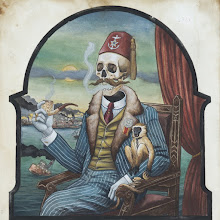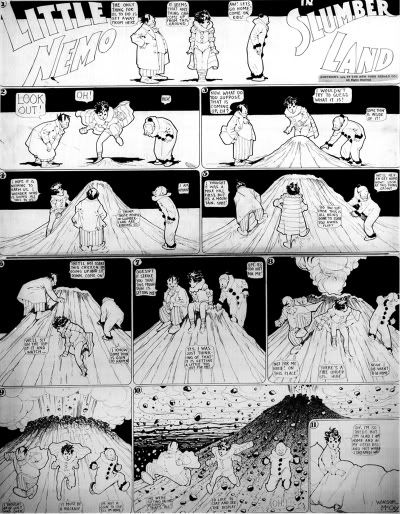Dreams of a Rarebit Fiend
Winsor McCay is best known as the creator of the turn of the century strip "Little Nemo in Slumberland", in which a young boy has surreal nightly adventures in the land of dreams. What he is less known for is his concurrent strip "Dreams of a Rarebit Fiend" ("Nemo" ran from 1905 to 1914, while "Rarebit Fiend" ran from 1904 to 1913.) While "Nemo" was, for all its disturbing and occasionally violent imagery, ostensibly a children's strip, "Rarebit Fiend" was firmly directed towards adults, and seems bizarre and edgy even in comparison to today's bland, content-regulated funny-pages fare.
Each "Rarebit Fiend" strip is highly formulaic. A semi-realistic situation is set up, which escalates over the course of seven or eight panels into pure surrealistic chaos - until the punchline of the last panel, which is always the same: the protagonist of the strip wakes up in bed, looking stunned and sheepish, swearing off "welsh rarebit" (or simply toasted cheese) before bed for good. Within this formula, however, McCay (who was forced to use the pseudonym "Silas" by the editor of the Herald, wherein his massively successful "Nemo" strip appeared and his real name was practically a brand name in and of itself) was given free reign to be as strange and imaginative as he wished, and "Dreams of a Rarebit Fiend" is full of Masonic rituals (see above), people growing antlers, fat jockeys crushing their horses, dead stoles coming back to life, and so forth.
"Little Nemo" was, without question, one of the first truly important newspaper cartoons (the first being "The Yellow Kid", published in the late 19th C. ) and it continues to have a phenomenal impact even today, on everyone from Matt Groening to Neil Gaiman - McCay set the stage for cartoonists to develop their own unique styles of illustration and storytelling, and the strip was of a consistently high quality from beginning to end. "Rarebit", on the other hand, tends to be a bit more uneven; it possesses a decidedly sketchy and compulsive quality, as if McCay were throwing each strip together in the middle of the night, inspired by his actual dreams.
Currently, there is no comprehensive collection of McCay's "Dreams of a Rarebit Fiend", but Dover has recently reprinted their 60-page trade paperback, which is worth picking up from from Amazon or your local retailer for the price alone. Dover has also re-released their "Little Nemo" collection, but it too is unfortunately incomplete. The best and highest-quality "Little Nemo" collection is the out-of-print "So Many Splendid Sundays", but until Sunday Press decides to release a 3rd edition, we'll have to content ourselves with the Dover collection and the McCay retrospective "Daydreams & Nightmares" (which is an excellent book in its own right, I should point out.)
Little Nemo in Slumberland



1 comment:
Next time you're down by the VPL, check out the Winsor McKay offerings in their "Golden Age of Animation" VHS -- not merely vaudeville exchanges with Gertie the Dinosaur, but Photoshop-calibre skewings of Little Nemo characters. It was a high point among all the Oswald the Rabbit imitators.
Post a Comment